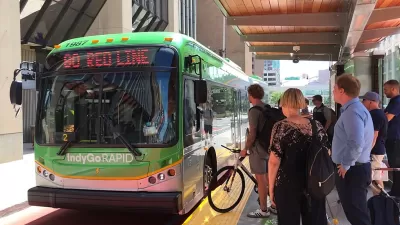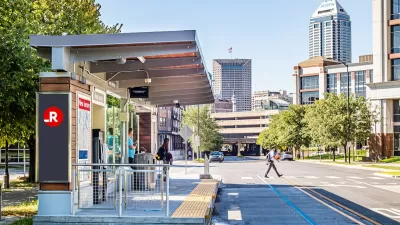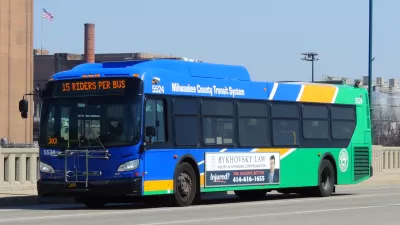In addition to connecting residents to jobs and medical facilities, city leaders hope the BRT line will boost economic development along the route.

Indianapolis city officials hope a new bus rapid transit line will bring economic development to a historically underserved neighborhood, reports Deon J. Hampton. "The Indianapolis Public Transit Corporation’s $188 million Purple Line, a 15-mile bus rapid transit, or BRT, system will eventually run from downtown to the neighboring city of Lawrence, providing access to jobs and healthcare for those who mainly depend on mass transit."
According to the article, the city wants to see new retail space and affordable housing developed along an eight-mile corridor along the new bus route. "In Indianapolis, many low-income residents on East 38th Street, especially those between College Avenue and Post Road in the northeast section of town, support the upcoming project, which would bring new infrastructure improvements such as new drainage and curbs."
However, some critics of the project express concern that the bus line will reduce access to some businesses and put transit farther from some residents by removing some existing bus stops. But proponents of BRT say the line will help low-income residents reach jobs and amenities. According to Scarlett Andrews, director of the city’s Department of Metropolitan Development in Indianapolis, "the city has modified its zoning code specifically for transit oriented development along the bus route in preparation of economic growth and connectivity along East 38th Street, a section of which has underutilized strip malls, declining housing developments and has turned into a center for public safety issues."
FULL STORY: Indianapolis looks to mass transit project to spur development in low-income area

Planetizen Federal Action Tracker
A weekly monitor of how Trump’s orders and actions are impacting planners and planning in America.

Congressman Proposes Bill to Rename DC Metro “Trump Train”
The Make Autorail Great Again Act would withhold federal funding to the system until the Washington Metropolitan Area Transit Authority (WMATA), rebrands as the Washington Metropolitan Authority for Greater Access (WMAGA).

DARTSpace Platform Streamlines Dallas TOD Application Process
The Dallas transit agency hopes a shorter permitting timeline will boost transit-oriented development around rail stations.

Parks: Essential Community Infrastructure — and a Smart Investment
Even during times of budget constraint, continued investment in parks is critical, as they provide proven benefits to public health, safety, climate resilience, and community well-being — particularly for under-resourced communities.

Porches, Pets, and the People We Grow Old With
Neighborhood connections and animal companions matter to aging with dignity, and how we build can support them. Here’s a human-scale proposal for aging in place.

Single-Stair Design Contest Envisions Human-Scale Buildings
Single-stair building construction is having a resurgence in the United States, where, for the last several decades, zoning codes have required more than one staircase in multi-story housing developments.
Urban Design for Planners 1: Software Tools
This six-course series explores essential urban design concepts using open source software and equips planners with the tools they need to participate fully in the urban design process.
Planning for Universal Design
Learn the tools for implementing Universal Design in planning regulations.
City of Charlotte
Municipality of Princeton
City of Camden Redevelopment Agency
City of Astoria
Transportation Research & Education Center (TREC) at Portland State University
US High Speed Rail Association
City of Camden Redevelopment Agency
Municipality of Princeton (NJ)





























